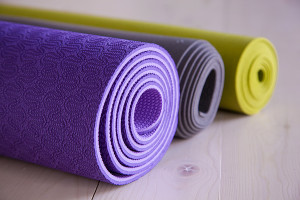
Are you a yoga enthusiast? According to a 2014 article in The Huffington Post, more than 20 million Americans practice yoga. Yoga Journal estimates that practitioners collectively spend nearly $27 billion dollars a year on classes, clothing and accessories. For many practitioners, a yoga mat is their first purchase. Last spring I learned that many yoga mats, including the one I had purchased, are made from toxic chemicals that can pose a significant health risk. The next time you’re doing downward dog, can you be sure you aren’t breathing in chemicals from your yoga mat? Let me tell you about my research.

Many currently available yoga mats contain PVCs and other toxic chemicals. It’s important to check your current mat, or look at the label if you are considering a new purchase.
Most yoga mats are manufactured in Asia and are made of polyvinyl chloride, or PVC. PVC is inexpensive and offers great gripping properties to mats. (I know I don’t want to be sliding around during my poses.) However, PVC has been listed by many organizations as the “most toxic plastic” currently in use. In addition, toxic chemicals including: phthalates (endocrine disruptors) are added to the PVC to make the mats soft and pliable. As endocrine disruptors they mimic the body’s hormones. We are exposed to these chemicals on our mats by breathing the slow off gassing, the evaporation of these chemicals and by simple skin contact.
I don’t know about you, but my yoga experiences include up close and personal contact with my mat.
Exposure to PVC through inhalation and skin contact can result in:
- The United States Centers for Disease Control and Prevention (the CDC) states that PVC causes damage to the liver, reproductive system, central nervous and respiratory systems.
- The “gripping” chemicals used in these mats are Phthalates, and they can cause cancer. (LIVESTRONG.com)
- Obesity
- Worsening allergy and asthma symptoms
- Increase potential for heart disease, breast cancer, and Type 2 diabetes (Elephant Journal)
- Developmental issues such as: inattention and hyperactivity. (Sarah Novak — Treehugger)
If you’re trying to get pregnant or already are, it’s important to note Phthalates in PVC have been linked to: (EcoNovice)
-

Pregnant women are at greater risk for possible PVC and other chemical exposures, because these chemicals can affect the reproductive system and unborn children.
Reduced fertility in women
- Reduced sperm counts in men
- Malformations of the male reproductive tract and testicular cancer
- Preterm birth and low birth weight babies
- Presence in the placenta and have been found in breast milk
- Possible ADHD in children
The manufacturing process:
Can you imagine the toxic exposure the workers who help produce these mats come under?
Disposal and the environment:
There is no safe way to destroy yoga mats made with PVC!
- They cannot be recycled because of the toxic chemicals used to make them.
- When incinerated or buried in landfills, they release dioxin, a known carcinogen. (Oprah)
- They are non-biodegradable, they leach chemicals into the soil and eventually the groundwater. (Dr. Mercola)
- When burned, PVC produces hydrogen chloride gas that is extremely toxic to fish, animals, and the air.
Based on this information, is there a human and earth friendly mat available for your healthy yoga practice?
Yes, Virginia, There Are Non-Toxic Yoga Mats!

Non-toxic yoga mats are made from a variety of natural materials and some incorporate jute, hemp or cotton — all of which are natural, sustainable and renewable resources that are biodegradable.
I was recently at my daughter’s hot yoga studio and was delighted to see that she provides and sells the Manduka line of mats. Based on my research here are my top three picks for non-toxic yoga mats, mats that are kind to ALL:
- www.manduka.com – Cushy, includes a lifetime guarantee, and this company is sustainably oriented: www.manduka.com/us/sustainability/
- www.barefootyoga.com/yoga-mats – Made from all-natural rubber and jute fiber, long lasting.
- www.mightynest.com – Thinksport Yoga/Pilates Mat by Think-Mad of lightweight TPE material (Thermo Plastic Elastomer), biodegradable, non-toxic and designed to decompose in landfills.
Here are other lines of mats made of natural rubber. For me, the smell is too strong, but it might not bother some of you. Here are a few companies that sell them:
- www.gaiam.com – They offer a nice variety of thicknesses
- www.jadeyoga.com – Buy a mat and they plant a tree
- www.pranayogamats.com – People give high marks for the Natural Sticky Mat
A heads up:

It’s important to read labels carefully to make sure that the yoga mat you select is actually made from non toxic materials, and is not just being marketed that way.
Some yoga mats may read that they are free of toxic phthalates and other chemicals but that doesn’t mean they don’t have any PVC. Just check with the manufacturer.
While I am not the avid yoga practitioner that many others are, I want to minimize any exposure to unhealthy toxins and chemicals in my living and working environment. The peace of mind that I get with having a toxic free, environmentally kind yoga mat for the days I do practice is huge.
What if I can’t afford a new yoga mat right now and what to do with the old toxic yoga mat?
For those with more limited budgets, I highly recommend covering your PVC mat with an inexpensive cotton towel.
When you are ready to purchase your new non-toxic yoga mat, use the old one as a rug pad instead of throwing it away. The beauty of this is that you are extending the life of any of your mats.
To all you folks who practice yoga, I honor you! For those of you who might be interested in this practice here is why it’s so popular.

A consistent yoga practice has many positive health benefits, including: decreased stress, greater flexibility and increased energy.
Some of the benefits of practicing yoga:
- Helps tone arms, legs and midsections
- Improves balance
- Builds core strength
- Reduces stress
- Increases flexibility
- Increases energy
- Increases sense of well being and health
- Improves cardiovascular and aerobic capacity
- Improves join and muscle stiffness and soreness
My personal favorite yoga practice is restorative. These poses involve the use of blankets and props for support. Whatever your practice, I hope today’s post helps bring awareness to going the extra step with your most prized and personal piece of yoga gear, your mat. I encourage you all to make a simple, healthy change for yourself by swapping out your current PVC mat for a healthy alternative.
Namaste, and be Healthy in your poses!
Sources:
Dr. Mercola
Elephant Journal (Nov. 2013)
EcoNovice (Sept. 2013)
LIVESTRONG (Jan. 2015)
Oprah
TreeHugger (Jan. 2012)
MightyNest
If you “Like” this post, I’d be thrilled if you’d share it.
FEB
